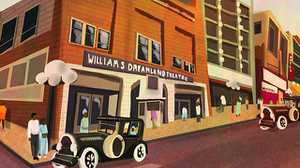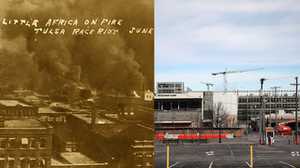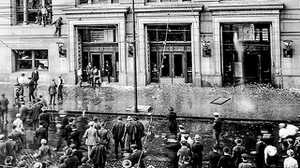Where Did Images of the Tulsa Race Massacre Come From?
White photographers took hundreds of photos of the race massacre. Why are they and the whites they photographed still anonymous?

The 1921 Tulsa Race Massacre is likely not only the most destructive but also the most photographed instance of anti-Black violence in American history. The quantity of photos and the prevalence of photo postcards suggests that as whites burned and looted the Greenwood District, they also wanted to document its destruction so that others could witness and vicariously participate in their triumphant defeat of a so-called “negro uprising.” This is not to suggest that every photo was taken for this purpose, but it is clear from inscribed captions such as “Running the Negro out of Tulsa” that whites who snapped pictures as Greenwood burned were impelled at least in part by the desire to convey a story of white conquest.
Perhaps the most chilling photos are those that show whites standing over the bodies of deceased Blacks or posing in front of building ruins. Who were the individuals pictured in these photos? Were they involved in the death and destruction, or were they mostly looters or curiosity seekers? Might white contemporaries viewing the photos today recognize the face of a friend or family member? If so, would they be willing to come forward with identifying information for those individuals?

This photo is one of a series of postcard views captioned “A Victim of the Tulsa Race Riot, June 1, 1921,” a group of male onlookers stand over the corpse of a race massacre victim. This photo was taken one block from the Frisco Railroad depot, where some of the heaviest gunfire between Blacks and whites occurred. As with lynching images, whites were not ashamed to be photographed alongside Black victims. White men who posed for such photos saw themselves as defenders of white womanhood and exemplars of white masculine courage.
Of course, merely knowing the names of white participants and spectators would be far from justice, but it would nonetheless be significant, in that it would remove white anonymity and provide at least a measure of accountability for some whites’ role in the massacre.
Unfortunately, it is doubtful that we will ever know the identities of the white civilians and civil authorities who participated in the destructive frenzy in the Greenwood District. When it comes to anti-Black violence, justice is too often permanently deferred.
The photographs do not and were not meant to provide a balanced or objective view of events. They do not depict the events that led to the armed invasion of Greenwood; nor do they show white mob participants engaged in the violent destruction. If such photos ever existed, they remain hidden away in private collections or have been destroyed over time. Rather, the available photos primarily depict the aftermath of the white rampage on the morning of June 1. The bulk of the photos show burned-out Greenwood homes and businesses along with armed white men rounding up the district’s Black community. Moreover, they frame what occurred almost exclusively from white Tulsans’ perspective.

In this photo, an armed white man strides authoritatively between Black detainees being moved to a detention center. During the race massacre, as many as five hundred white men were appointed as special deputies with the power to arrest and even kill Black people.
Of more than 500 photographs, only the half-dozen images by photographer Reverend Jacob H. Hooker, himself a survivor of the massacre, are attributed to a Black person. Reverend Hooker’s photos poignantly capture the destruction and rebuilding of Greenwood. Unfortunately, his photography studio, located at 22 North Elgin Avenue, was burned down during the massacre and was never rebuilt.

In this photo, Black child separated from his parents and under the care of the Red Cross until family members could be identified. According to Red Cross figures, more than 400 detached persons were widowed or orphaned as a result of the massacre.
An extensive race massacre photo archive exists because so many white participants desired to visually represent and share with other whites their role in the violent destruction of the Greenwood District. White Tulsans’ eagerness to photograph the community’s devastation was reflective of turn-of-the century lynching culture, in which photography was central.

In this photo, against a backdrop of desolation, a white man seemingly poses behind some downed electrical wires on Greenwood Avenue. The whites who came to gawk at the destruction did little to help the community rebuild after the massacre.
By and large, lynching culture revolved around white mobs torturing and summarily killing Black people in public. White-on-Black lynching often became a public spectacle, with as many as several thousand people in attendance. White mobs sought to portray the white community as undifferentiated and united in enacting white supremacy through terroristic violence enacted upon Black bodies. For example, photo postcards of lynchings often pictured a crowd of gleeful whites posing near a lynched Black body. According to historian Amy Wood, there was an appetite among white Americans for witnessing a lynching because it gave them social authority in telling the story as well as the ability to frame themselves as protectors of the community.
The white Tulsans who invaded Greenwood similarly portrayed themselves as protectors, defending their community against an armed “negro uprising.” Through taking or sharing photos of destroyed Greenwood buildings and, especially, of armed whites escorting Black men with their hands raised in surrender, white participants and onlookers sought to demonstrate that white Tulsans had succeeded in thwarting Black violence.

This photo shows that entire families were loaded onto trucks and transported under armed guard to detention centers.
Captions such as “Running the Negro out of Tulsa,” “Little Africa on Fire,” and “Herding Them in the Convention Hall” are indicative of this cultural ethos. Race massacre photos were valued as souvenirs that enabled their authors to credibly inscribe themselves into a triumphalist narrative. This is particularly true of those later sold as photo postcards, which also allowed those who purchased and sent them, as well as the recipients who then viewed them, to vicariously share in that triumph.
Although white mob participants enthusiastically took pictures of Greenwood’s destruction, most did not leave a documentary record that would later allow their photos to be traced back to them. This was not an uncommon dynamic. As with lynching photography, rarely did white photographers or whites pictured in race massacre photos identify themselves. The bulk of the images for which a specific creator can be identified were taken by amateur white male photographers.
Looking at these photos 100 years later, we see whites standing alongside dead bodies and destroyed buildings. We see whites walking casually through the district as it burns. These photos remind us of the lack of accountability of those who participated or witnessed and did nothing. We must ask how the city of Tulsa and the state of Oklahoma enabled the perpetrators and, despite photographic evidence, protected them afterwards.
These photos are painful reminders of just how impervious white authorities have been to the suffering of victims, survivors and their descendants. It would mean a tremendous amount if these photos could beckon white people to acknowledge whom they know among the depicted perpetrators and witnesses and how they are related.
This article is an edited excerpt from Karlos K. Hill’s book The 1921 Tulsa Race Massacre: A Photographic History.

Karlos K. Hill is Regents’ Professor and Chair of the Clara Luper Department of African and African American Studies at the University of Oklahoma. He is also the author of Beyond the Rope: The Impact of Lynching on Black Culture and Memory and The Murder of Emmett Till: A Graphic History.







